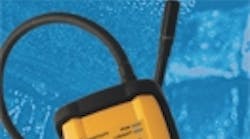Fieldpiece Instruments’ SRL2K7 Infrared Refrigerant Leak Detector kit gives field technicians premium performance in an ergonomic, rugged design, spokespersons say. The kit includes all the accessories needed to take accurate measurements for refrigerant leak detection.
According to company sources, the instrument’s infrared sensor gives technicians superior sensitivity in the field: 0.1-oz. per year. And, it doesn’t trigger on oil and moisture like other types of refrigerant sensors. The infrared sensor is designed to last for many years without the need for replacing. The SRL2 has the added protection of a replaceable water-blocking filter that keeps moisture and contaminants from reaching the sensor, preventing contaminant-related failure.
A rechargeable, 8-hour lithium-ion polymer battery powers the unit for a full day of testing. The instrument is self-calibrating and recalibrates quickly. The sensor arm is non-conductive and stays in place when positioned by the technician. Both a visual and audible alarm sound when a CFC, HFC or HCFC blend refrigerant leak is detected.
Visit www.fieldpiece.com for additional information. — Fieldpiece
Controller Reverses Refrigerant Flow During Defrost
Master-Bilt’s master controller, with a patented reverse cycle defrost, uses a reverse cycle valve that’s added to the condensing unit, which reverses the direction of refrigerant flow during defrosts. The reverse cycle is automatically activated by the Master Controller electronic control system.
When the master controller demand/defrost feature determines a defrost is necessary, the reverse cycle valve is automatically activated and the high temperature refrigerant flow is reversed through a multi-step process. Once triggered, the refrigerant flows back through the evaporator coil, heating it along its entire length and completely eliminating frost buildup.
According to company sources, traditional electric defrost heaters only heat a certain amount of the coil, leaving ice deposits that weaken the evaporator’s performance. The process uses less energy than electric defrost heaters, resulting in an 80% reduction in defrost energy usage. Master-Bilt sources say reverse cycle performs a completely “clean” defrost in three to five minutes, with no noticeable increase in freezer temperature.
Visit www.master-bilt.com for additional information. — Master-Bilt
| CALL FOR NOMINATIONS Contracting Business is seeking nominations for its Third Annual Commercial Refrigeration Contractor of the Year award. The winner will be announced in a feature article in the May, 2009 edition of Contracting Business. The Commercial Refrigeration Contractor of the Year: • Consistently demonstrates a commitment to quality installation, service, industry involvement, and customer relations; • Is on the cutting edge of the latest technology; The award will be presented at the Refrigeration Service Engineers Society (RSES) annual meeting, October 28-31, 2009, in Minneapolis, MN. The winner is expected to be present to accept the award. Send nominations, with supporting information, to Terry McIver, executive editor at [email protected]. |











